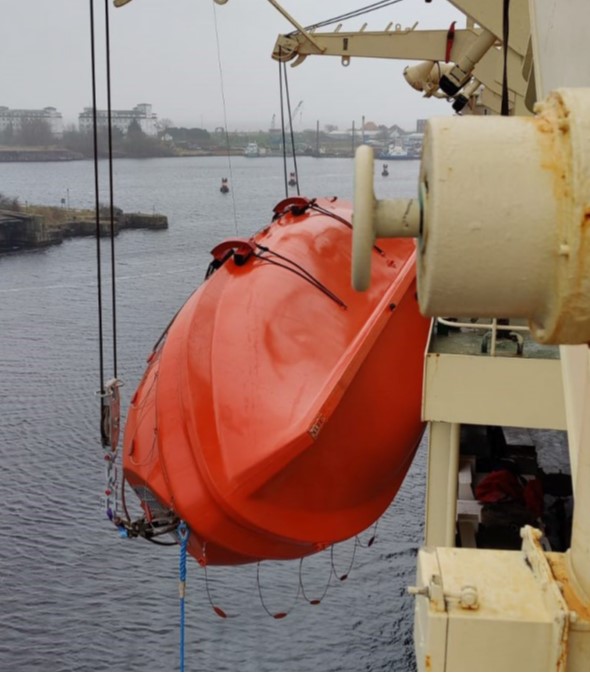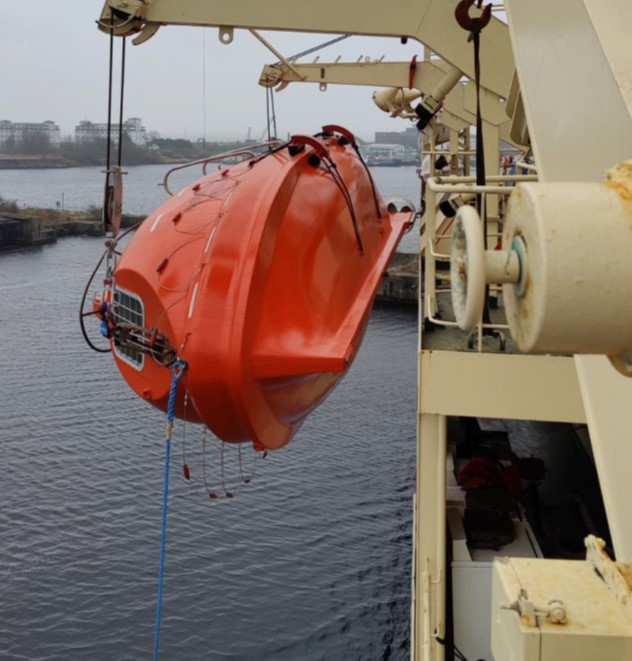USCG: Unexpected Dangers: Lifeboat Remote Control Wires
The United States Coastguard (USCG) has published Safety Alert 07-22 which addresses the importance of visually inspecting lifeboat and davit installations before testing with crewmembers on board, and ensuring crew familiarity with company policy related to lifesaving equipment testing. In particular, the remote control wire may be overlooked, yet weaknesses within the linkages or poor spooling of the wire itself can lead to catastrophic failures in the lifeboat launching systems.


What happened
During a recent vessel inspection, a vessel’s crew was lowering the lifeboat when the remote control wire arrangement caused two separate failures:
- The remote control wire parted as the lifeboat was being lowered with crew on board. Causal factors included poor winch spooling potentially hidden under the outer spools, which led to a wire kink and winding on itself, creating enough force to part the wire;
- The second failure occurred a day later after the replacement remote control wire was hand spooled from extra wire found on board. During testing with crew on board the boat using the remote control wire to lift the brake, an unexpected pay out of wire led to the winch brake prematurely engaging, which made the lifeboat stop lowering and swing erratically above the embarkation deck. Seconds later, the movement caused the wire to regain tension, which lifted the winch brake arm and caused the lifeboat to lower again. While lowering in a swinging motion, the skeg of the lifeboat caught on the knife-edge of the ship’s deck, causing the lifeboat to list more than 90 degrees.
What went wrong
An internal company investigation of these incidents identified the crew did not follow existing company policy which required a test lowering without crew prior to embarking crew. The company’s policy is based on recommendations within MSC.1-Circ.1578, Guidelines on Safety During Abandon Ship Drills Using Lifeboats.
What went right
Quick action of a crewmember who activated the winch brake lever from the deck – otherwise the lifeboat could have inverted further and led to catastrophic outcomes.
Recommendations
The USCG strongly recommends that ship’s crew conduct a thorough visual inspection of lifeboat launching systems and test lowering prior to operation with crew on board, paying special attention to the following inspection points:
- Verify the proper spooling of the remote control wire, expand inspection as necessary;
- Verify the proper position of the remote control wire weight. If the weight is very close to the top of the lifeboat, this may indicate the remote control wire is too long;
- Verify material condition of the shackle that connects the pull cable to the remote control wire within the lifeboat. These steel shackles can corrode and may be overlooked during weekly/monthly/annual inspections.
Members may wish to refer to:
Safety Event
Published: 20 July 2022
Download: IMCA SF 18/22
IMCA Safety Flashes
Submit a Report
IMCA Safety Flashes summarise key safety matters and incidents, allowing lessons to be more easily learnt for the benefit of all. The effectiveness of the IMCA Safety Flash system depends on Members sharing information and so avoiding repeat incidents. Please consider adding [email protected] to your internal distribution list for safety alerts or manually submitting information on incidents you consider may be relevant. All information is anonymised or sanitised, as appropriate.
IMCA’s store terms and conditions (https://www.imca-int.com/legal-notices/terms/) apply to all downloads from IMCA’s website, including this document.
IMCA makes every effort to ensure the accuracy and reliability of the data contained in the documents it publishes, but IMCA shall not be liable for any guidance and/or recommendation and/or statement herein contained. The information contained in this document does not fulfil or replace any individual’s or Member's legal, regulatory or other duties or obligations in respect of their operations. Individuals and Members remain solely responsible for the safe, lawful and proper conduct of their operations.
